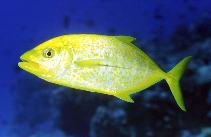Flavocaranx bajad (Fabricius, 1775)
Orangespotted trevally
Envoyez vos Photos et vidéos
Pictures | Videos | Images GoogleFlavocaranx bajad
Picture by Patzner, R.
Pictures | Videos | Images GoogleFlavocaranx bajad
Picture by Patzner, R.
United Arab Emirates country information
Common names:
[No common name]
Occurrence: native
Salinity: marine
Abundance: | Ref:
Importance: | Ref:
Aquaculture: | Ref:
Regulations: | Ref:
Uses: no uses
Comments:
National Checklist:
Country Information: https://www.cia.gov/library/publications/resources/the-world-factbook/geos/tc.html
National Fisheries Authority:
Occurrences: Occurrences Point map
Main Ref: Smith-Vaniz, W.F., 1984
National Database:
Occurrence: native
Salinity: marine
Abundance: | Ref:
Importance: | Ref:
Aquaculture: | Ref:
Regulations: | Ref:
Uses: no uses
Comments:
National Checklist:
Country Information: https://www.cia.gov/library/publications/resources/the-world-factbook/geos/tc.html
National Fisheries Authority:
Occurrences: Occurrences Point map
Main Ref: Smith-Vaniz, W.F., 1984
National Database:
Common names from other countries
Classification / Names Noms communs | Synonymes | Catalog of Fishes(Genre, Espèce) | ITIS | CoL | WoRMS | Cloffa
> Carangiformes (Jacks) > Carangidae (Jacks and pompanos) > Caranginae
Etymology: Flavocaranx: Name from Latin 'favo' meaning 'yellow' and Caranx, which is the type genus of Carangidae; referring to yellowish body color.
Etymology: Flavocaranx: Name from Latin 'favo' meaning 'yellow' and Caranx, which is the type genus of Carangidae; referring to yellowish body color.
Environment: milieu / climate zone / depth range / distribution range Écologie
marin récifal; profondeur 2 - 70 m (Ref. 90102). Tropical; 35°N - 8°S, 33°E - 150°E
Distribution Pays | Zones FAO | Écosystèmes | Occurrences | Point map | Introductions | Faunafri
Indo-West Pacific: Red Sea, Gulf of Aden, Persian Gulf, and the Gulf of Oman to Indonesia, the Gulf of Thailand, the Philippines, and Okinawa, Japan.
Length at first maturity / Taille / Poids / Âge
Maturity: Lm 24.7 range ? - ? cm
Max length : 55.0 cm TL mâle / non sexé; (Ref. 3287); common length : 42.0 cm TL mâle / non sexé; (Ref. 5450)
Max length : 55.0 cm TL mâle / non sexé; (Ref. 3287); common length : 42.0 cm TL mâle / non sexé; (Ref. 5450)
Description synthétique Clés d'identification | Morphologie | Morphométrie
Épines dorsales (Total) : 9; Rayons mous dorsaux (Total) : 24 - 26; Épines anales: 3; Rayons mous anaux: 22 - 24.
Adults are common along coastal reef slopes or around large coral heads in lagoons (Ref. 48635). A xanthic form often seen in muddy bays mixes in schools (Ref. 48635). Juveniles solitary in sheltered coastal basys (Ref. 48635).
Life cycle and mating behavior Maturité | Reproduction | Frai | Œufs | Fécondité | Larves
Référence principale
Upload your references | Références | Coordinateur : Smith-Vaniz, William F. | Collaborateurs
Smith-Vaniz, W.F., 1984. Carangidae. In W. Fischer and G. Bianchi (eds.) FAO species identification sheets for fishery purposes. Western Indian Ocean fishing area 51. Vol. 1. [pag. var.]. FAO, Rome. (Ref. 3287)
Statut dans la liste rouge de l'IUCN (Ref. 130435: Version 2024-1)
Préoccupation mineure (LC) ; Date assessed: 06 March 2015
Menace pour l'homme
Harmless
Utilisations par l'homme
Pêcheries: commercial; pêche sportive: oui
FAO(pêcheries: production; publication : search) | FishSource | Sea Around Us
Plus d'informations
Trophic ecology
Éléments du régime alimentaire
Composition du régime alimentaire
Consommation alimentaire
Food rations
Prédateurs
Éléments du régime alimentaire
Composition du régime alimentaire
Consommation alimentaire
Food rations
Prédateurs
Population dynamics
Paramètres de croissance
Max. ages / sizes
Length-weight rel.
Length-length rel.
Fréquences de longueurs
Mass conversion
Recrutement
Abondance
Paramètres de croissance
Max. ages / sizes
Length-weight rel.
Length-length rel.
Fréquences de longueurs
Mass conversion
Recrutement
Abondance
Anatomy
Surface branchiale
Brain
Otolith
Surface branchiale
Brain
Otolith
Physiology
Body composition
Nutrients
Consommation d'oxygène
Type de nage
Vitesse de nage
Visual pigments
Fish sound
Diseases & Parasites
Toxicity (LC50s)
Body composition
Nutrients
Consommation d'oxygène
Type de nage
Vitesse de nage
Visual pigments
Fish sound
Diseases & Parasites
Toxicity (LC50s)
Genetics
Génétique
Heterozygosity
Héritabilité
Génétique
Heterozygosity
Héritabilité
Human related
Aquaculture systems
Profils d'aquaculture
Souches
Ciguatera cases
Stamps, coins, misc.
Aquaculture systems
Profils d'aquaculture
Souches
Ciguatera cases
Stamps, coins, misc.
Outils
Bio-Quiz | E-book | Guide de terrain | Clés d'identification | Générateur de fréquences de longueur | Outil de dynamique de population | Carte par point | Classification Tree
| Catch-MSY |
Articles particuliers
Télécharger en XML
Sources Internet
Aquatic Commons | BHL | Cloffa | Websites from users | FishWatcher | CISTI | Catalog of Fishes(Genre, Espèce) | DiscoverLife | ECOTOX | Faunafri | Fishtrace | GenBank(génôme, nucléotide) | GloBI | GOBASE | | Google Books | Google Scholar | Google | IGFA World Record | MitoFish | Bases de données nationales | Otolith Atlas of Taiwan Fishes | PubMed | Reef Life Survey | Scirus | SeaLifeBase | Arbre de Vie | Wikipedia(aller à, chercher) | World Records Freshwater Fishing | Zoological Record
Estimates based on models
Preferred temperature (Ref. 115969): 25.5 - 29.2, mean 28.5 (based on 944 cells).
Phylogenetic diversity index (Ref. 82804): PD50 = 0.5000 [Uniqueness, from 0.5 = low to 2.0 = high].
Bayesian length-weight: a=0.01175 (0.00778 - 0.01775), b=2.92 (2.80 - 3.04), in cm Total Length, based on LWR estimates for this species & (Sub)family-body (Ref. 93245).
Niveau trophique (Ref. 69278): 4.3 ±0.59 se; based on food items.
Résilience (Ref. 120179): Milieu, temps minimum de doublement de population : 1,4 à 4,4 années (Tmax=8; K = 0.24-0.59).
Fishing Vulnerability (Ref. 59153): Moderate vulnerability (39 of 100).
Climate Vulnerability (Ref. 125649): Very high vulnerability (90 of 100).




